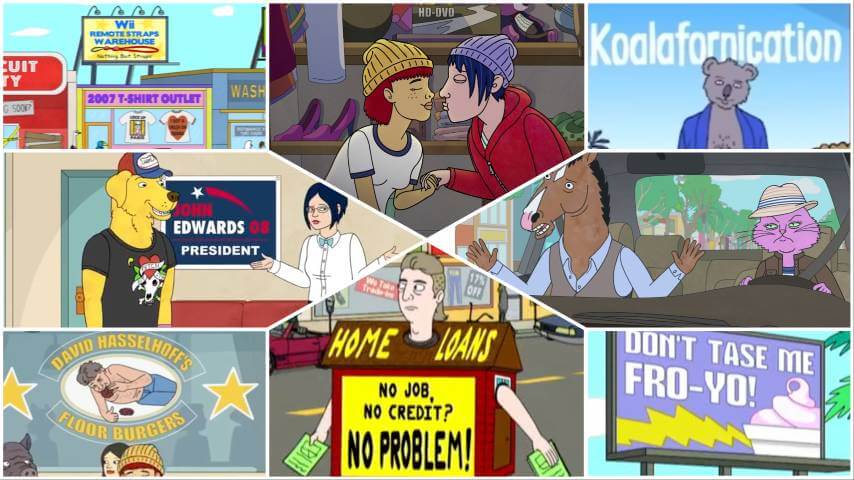Back in the 2010s, there was a very famous TV show, one that captured The A.V. Club‘s imagination for six seasons. As BoJack Horseman turns 10 this week, we’ll be looking back at the engrossing animated comedy with a series of essays and interviews. This is BoJack Horseman Week.
Nostalgia takes time because people need something to miss. Even with a pandemic and a Trump presidency between us, 2016 doesn’t look so different from 2024. Period pieces, costume dramas, and flashbacks help make sense of this, codifying an era into bite-sized morsels. American Graffiti, Happy Days, and Grease don’t accurately define pre-Beatles America but nevertheless create stereotypical symbols of ’50s Americana. Each generation does the same with their adolescence. In the late ’90s, Adam Sandler looked into the then-recent past, setting The Wedding Singer in a very ’80s 1980s. Its once-obvious specifics become part of the background the more time passes. Today, Stranger Things takes its cues from the ’80s without Robert Smigel pointing to his shirt and suggesting, “Relax, don’t do it.” Still, for the last 100 years or so, part of growing up is seeing the world you grew up around depicted back at you on screen.
Throughout its run, BoJack Horseman operated similarly to Mad Men or Lost, frequently returning to the past to illuminate the present. During the show’s first two seasons, audiences were treated to the premature death of BoJack’s innocence as Little BoJack Fauntleroy’s emotional wires cross, tying Secretariat and parental neglect together. Two episodes into its third season, BoJack Horseman took another detour, this time into recent Hollywoo history. “The BoJack Horseman Show” jumped back in time to 2007, a short window for a flashback but fertile ground for comedy.
Speaking to The Daily Beast about the episode, Bob-Waksberg said he was “tickled” by the idea of “doing a nostalgia flashback episode about a time that wasn’t that long ago […] It felt really fresh to treat 2007 as a nostalgia object and overplay how different things were back then and how wacky and backwards the past was when most people watching it feel like that was just yesterday.” Borrowing the structure of season one’s “The Telescope,” which similarly made a five-course meal out of ’80s and ’90s references, the episode opens with a barrage of cultural signifiers. Princess Carolyn rocks H&M’s hottest denim skirt, striped shirt, and fedora combo. Her car radio blares an auto-tuned generic 2000s pop song, and Todd, with the flat-ironed hair of an emo god, eats at David Hasselhoff’s Floor Burgers.
Bob-Waskberg and company were among the first to reference The Hills and HD DVD players as nostalgia objects, showing how the world has changed since 2007. Even if BoJack hasn’t. Still licking his wounds over Horsin’ Around, BoJack hasn’t done much since betraying his ex-partner, Herb, sabotaging the show and his sense of self. However, those around him are making moves. Then a barista/caterer/waiter, Diane, a.k.a. Blarn, makes Americanos with steamed milk instead of water for Mr. Peanutbutter, still an unknown dreamer whose “second and final wife,” Jessica Biel, is on a career downslope. (One of the episode’s now-deepest cuts is the brief period in the 2000s when Jessica Biel-focused amnesia ran rampant). Princess Carolyn is also on the up-and-up, scoring BoJack a role in the long-awaited television return of Krill & Grace creator Cuddlywhiskers. But irony clouds their optimism. The audience knows they’re cheerfully working toward tragedy in the present.
Watching a period piece from a time before your own has a transportive effect, albeit one at a remove. When it aired, “The BoJack Horseman Show” closed the temporal gap and forced viewers to see the past as something closer, especially for millennials, who had not yet seen their youth depicted on screen. Not too long ago, Diane, a vessel for the millennial malaise if there ever was one, was an auspicious writer who read her first “Shouts & Murmurs” rejection letter with the hope that Eustace Tilley read and considered her submission. She’s also the same Diane looking for outside validation from a parent who barely registers her as a daughter. Even dressed up in 2007’s trappings, the disappointments still sting. In her mid-30s, Diane would do anything to return to her 20s, but many of the same problems await her there. It’s a lesson BoJack learns as he takes another last shot at legitimacy: if you constantly seek outside validation, you’ll never do anything.
BoJack ended Baby Boomers and Gen X’s monopoly on period pieces and signaled to its millennial viewership that their adolescence, too, would become window dressing for entertainment. Sure enough, within five years, Pen15 made the blue iMac and choker necklaces a foundational part of its aesthetic. Comedians Tim Robinson and Connor O’Malley were mining their Warped Tour memories for specific types of masculinity. Fleischman Is In Trouble returned to the summer “BoJack Horseman Show” aired (and some other things happened). More recently, Sundance breakout Dídi brought audiences back to the MySpace era internet.
Period pieces don’t simply depict coming of age. They are part of coming of age. Today, 17 years after 2007, “The BoJack Horseman Show” looks like any other period piece. Its loudly overserved specifics dulled as cultural nostalgia for Bush-era “indie sleaze” grows. With 2024 eyes, seeing the cultural loop in the spin cycle again is even funnier. In 2016, it was impossible to believe that Mr. Peanutbutter’s Ed Hardy and Von Dutch gear were ever fashionable. Now that ugly tattoo t-shirts are staging a comeback, Ed Hardy is vintage, not passé. And if calling Ed Hardy vintage doesn’t age you, 2007 nostalgia certainly will.

